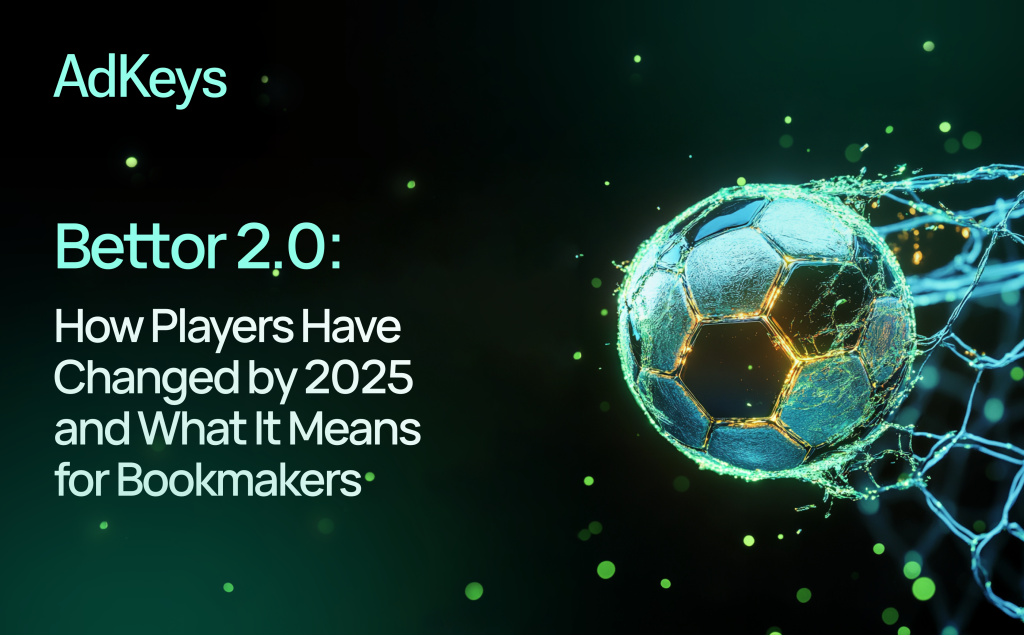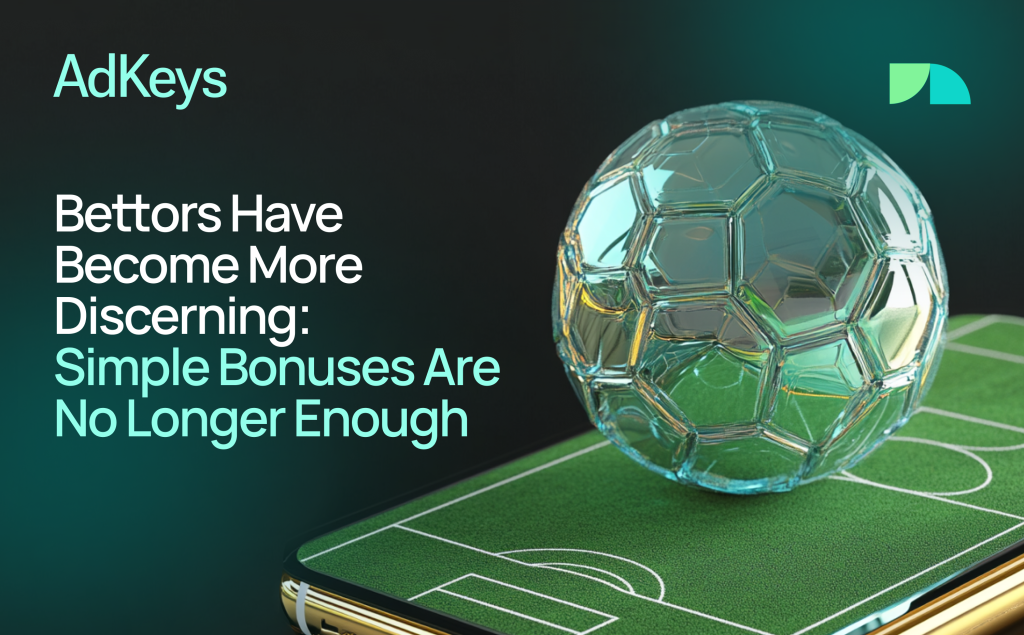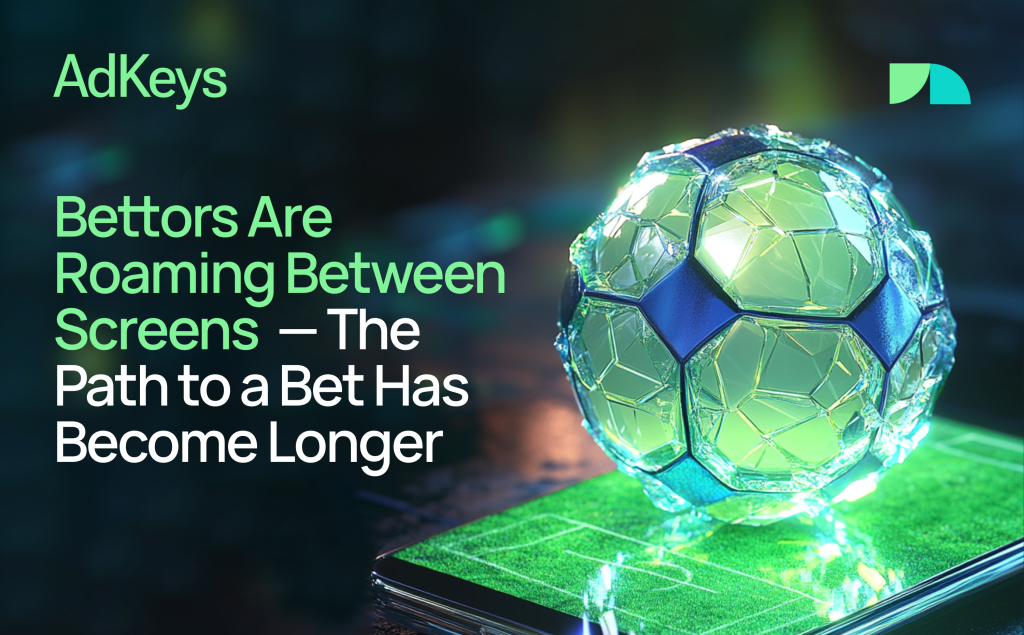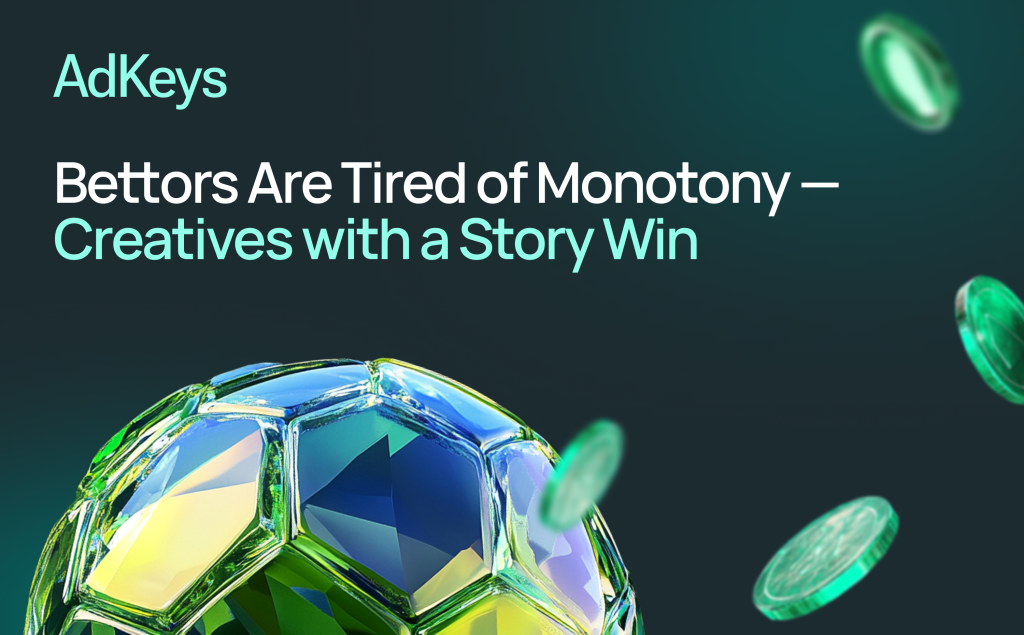
The betting industry is evolving through new technologies, taking into account changes in user psychology and the overall profile of the target audience. The modern bettor is no longer someone who in the 2010s bet on “moment realization” and ran to betting shops for cash. Today, this is an advanced user who is accustomed to convenience, instant access to money, and personalized offers. In this article, the AdKeys team will analyze what the bettor has become in 2025 and what is now important for bookmakers’ advertising campaigns.
Mobile Betting: Up to 90% of Bets from Smartphones

If in 2015 mobile was a pleasant addition to desktop, now it is the main channel for betting — in 2023, over 80% of bets were already made online or in mobile applications. According to H2 Gambling Capital data, by the end of 2025, mobile bets could account for over 90% of sports betting revenue.
What do players expect from mobile?
- Instant interface loading — every extra second of waiting reduces conversion.
- Great app usability — the “Place Bet” button should be where it’s intuitively looked for.
- Simplified User Flow — the easier it is to place a bet, the higher the betting frequency
Fact: Bookmakers are shortening the user's path from selecting an event to placing a bet. Ideally — in 2 clicks.
What does this mean for advertising campaigns?
Advertising also needs to be more mobile-focused: vertical formats, concise messages, bright call to action — everything should work from the first swipe. Sources — as mobile-first as possible: social networks, YouTube Shorts, pushes, and in-app advertising through RTB networks. Offers — simple and clear, without “up to ₽5000 bonus with a deposit from ₽4270”: better “Bet in 2 clicks — money in your account in 5 minutes.”
Creatives demonstrating the interface, UX animation, and live scenarios are effective.
Bettors Have Become More Discerning: Simple Bonuses Are No Longer Enough

If previously a player could be attracted by a large free bet or deposit bonus, now the user evaluates the bookmaker as an online service: with a convenient interface, fast payouts, and adequate support. What has become important:
- Personalization — if offers precisely match user interests, rather than offering a bet on the Nicaraguan championship, the probability of conversion is higher.
- Transparent conditions — users dislike hidden restrictions and complex wagering requirements.
- Quality content — analytics, insights, expert predictions, and news are increasingly of interest to bettors.
Fact: The 2025 bettor is no longer a freeloading hunter but a user with habits from e-commerce and streaming. And the one who speaks their language wins — not just with promos, but with UX.
What does this mean for advertising campaigns?
One banner “₽1000 for the first deposit” will no longer appeal to everyone. Better — a personalized offer based on behavioral data. Sources — programmatic, in-app, social media retargeting. In creatives — fewer abstract words, more real value: payout speed, intuitive navigation. And bonuses haven’t been canceled, of course.
Bettors Are Roaming Between Screens — The Path to a Bet Has Become Longer

Today’s player is not someone who saw a banner and immediately went to register. They might first encounter a brand on TikTok, then see a review on Telegram, click an ad on Shorts, install an app on their smartphone, and place their first bet via desktop. The path is spread out — and has become more complex.
Fact: According to AppsFlyer data, almost every second bettor interacts with advertising on 3 or more devices before their first bet.
What does this mean for advertising campaigns?
- You can no longer rely on a single channel. An omnichannel strategy is needed — considering social networks, advertising networks, blogs, media.
- Without end-to-end analytics, it’s easy to lose a player. The AdKeys team helps connect the user’s path into a single chain.
- Creatives need to be adapted to the platform: on TikTok and YouTube Shorts, stories work better; in apps, concise offers.
- Retargeting is mandatory. The chain works best: first a teaser, then an explanatory creative, then a specific offer. And you can also catch users when they leave a competitor’s app — through programmatic and RTB.
Bettors Are Tired of Monotony — Creatives with a Story Win

Users have seen “₽1000 bonus” a million times. Now, it’s not the numbers that hook them, but the plot — a mini-drama, a joke, a relatable situation. Especially if all this happens in their familiar environment — on TikTok, in Stories, in Shorts, or in an app.
Fact: According to AdKeys A/B tests, video creatives with a simple scenario or life hacks show a CR 1.5–2.3 times higher than banners.
What does this mean for advertising campaigns?
- Scenarios work: “Life hack: how to recoup your taxi fare with a bet.”
- Playables are successful when they show the bettor’s journey: event selection — bet placement — withdrawal of funds.
- Emotion is more important than the offer. Especially for young people: they don’t need ₽500, they need a story or a viral moment. AdKeys, for example, tests hypotheses in production: from plot type to CTA, and scales successful formats. Different platforms = different approaches. On TikTok — humor, on Telegram — insider info, on Stories — quick promotions.
Personalization — It's No Longer a Feature, But a Must-Have

Bettors want to be addressed personally. Not “bet on football,” but “Did you see that goal today?” Not just a bonus, but a bonus for interest in a specific league or team. The more precise the targeting, the higher the chance of conversion and return.
Fact: According to Adjust data, personalized campaigns in betting yield +27% to conversion and +35% to LTV.
What does this mean for advertising campaigns?
- Offers should be dynamic — changing the bet, event, and CTA depending on user interests.
- AdKeys suggests building segmentation based on behavioral characteristics: who bets live, who bets parlays, who likes UFC, and who likes tennis. And using data from different platforms to adapt creatives: what they are interested in, where they play most often, what they watch.
- You can launch retargeting with personal messages: “Time to get your luck back in the NBA — jump in!”
The First Bet Is Not the Main Thing. The Main Thing Is That They Return
In an era of expensive traffic, advertisers have started to look not at CPI, but at LTV. One user who bets every weekend is more valuable than ten one-day wonders. Therefore, the race is not for the number of installations, but for retention.
Fact: According to AdKeys analytics, in betting, up to 80% of advertising budgets go to acquisition, although returning players generate more revenue — especially in high-LTV segments.
What does this mean for advertising campaigns?
- Advertising should be shown not only to new but also to dormant players: via push, social networks, event-based retargeting.
- The AdKeys team considers it optimal to select a suitable offer or approach for advertisers using conducted tests and hypotheses.
- The highest CR is for creatives that “guess the moment”: for example, a bet after a disappointing loss or a bonus for a rematch in a favorite sport.
- Dynamic advertising based on behavior makes sense: those who recently bet will receive a repeat offer; those who haven’t played for a long time will see “we missed you.”
- And most importantly — a human tone. Not “come back and get a bonus,” but “we know you can get revenge.”
How Are the Demographic Characteristics of Bettors Changing?

2025 is the time when betting ceases to be an “insider game” and becomes a mass digital product. This means that marketing must also work precisely.
Generation Z: Born with a Phone in Hand, Bet in a Couple of Clicks
Gen Z are those who have been accustomed to social networks, memes, and personalized feed algorithms since childhood. For them, betting is part of digital entertainment, just like games, streams, and online shopping. They are not interested in bulky blocks of text; they want quick access to odds, convenient mobile apps, and gamification.
How to attract them:
- Short video format with dynamic narrative and humor (on TikTok, Reels, YouTube Shorts)
- Interactive promos: quizzes (“Guess the score — get a free bet”), challenges.
- Influencers, but not classic tipsters, rather those who create content in the style of “a friend explains how to make money on bets.”
What won’t work: standard banners and long reads, serious analytical predictions without emotions.
Millennials: Betting as a Strategy, Not Pure Gambling
These players have matured, learned to calculate ROI, and know that without statistics, there’s nothing to do here. They value analytical content, love comparing odds, and study tactics. Trust in the brand, fair conditions, and adequate support are important to them.
How to attract them:
- Value betting, match analysis, and discussions.
- YouTube reviews with strategy breakdowns.
- Personalized offers (“You bet on the EPL? Catch boosted odds for the next match!”).
What won’t work: free predictions from “great” tipsters, aggressive marketing with promises of 300% profit.
40+: Conservatives, But With Money
This audience consists not of impulsive high-rollers but people who have come to betting consciously. They have capital but don’t jump at the first offer. They are interested in reliability, clear rules, and stable payouts.
How to attract them?
- Classic media: RBC, Sport-Express, thematic forums.
- Expert ambassadors: former athletes, coaches, journalists.
- Detailed guides and instructions (“How not to fall for arbers,” “Why it’s important to check licenses”).
What won’t work: fast-food content in the style of TikTok, “emotional” bets (e.g., “parlays with odds of 100”).
Underrated Audience — Women Bettors
For a long time, betting was considered a “male” activity, but everything is changing. Women are gradually entering betting, especially in tennis, esports, and entertainment bets. They are more inclined towards long-term strategies and careful bankroll management.
How to attract them:
- Native advertising in lifestyle media.
- Support for women’s sports and ambassadors among female athletes.
- Interface design that is beginner-friendly (fewer complex terms, more visual cues).
What won’t work: advertising creatives only with male images, ignoring UX/UI for beginners.
